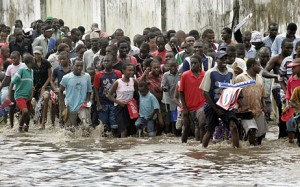In two years time 24 100m-plus-high power generators able to produce 50 MW of power (almost 10% of Tanzania’s current power needs) are due to have been erected in Nijapanda village in Singida region as part of the first commercial wind farm in sub-Saharan Africa. The company behind the $113m project is ‘Wind East Africa.’ “It’s important that Tanzania diversifies its power sources,” says project manager Mike Case. “The country is very reliant on hydro-electric power, which means that in times of drought, there is a power deficit. Oil-generated power is very expensive, so wind power offers a cheaper and more reliable alternative.”
The demand for power in Tanzania is growing by more than 50 MW a year, fuelled partly by an expansion of gold and nickel mining in the north of the country. At present, electricity is sourced from power plants more than 1000 kms away. This first wind farm will mean that power-hungry industries will soon be provided with electricity generated locally.
According to wind expert Dr Ladislaus Lwambuka, from the University of Dar es Salaam, Africa is now ready for wind power on a commercial scale. There are already plans, if the first phase of the project goes well, to double the number of wind turbines and increase Wind East Africa’s output to up to 100 MW – BBC News.
 People braving torrential rain to see the Olympic Torch procession pass through Dar-es-Salaam
People braving torrential rain to see the Olympic Torch procession pass through Dar-es-Salaam
The Olympic Torch for the Beijing Olympic Games passed through Dar-es-Salaam as the only African leg on its world tour to reach China. Thousands of people turned out to watch the procession despite torrential rain and flooding. There were no reports of protests which have affected the other legs of the torches journey.

An article on the BBC NEWS website ( 10th April) describes how a small army of women are trying to restore the labyrinthine alleys and carved wooden doors of Zanzibar Stone Town. “Among them is 31-year-old Asma Juma, one of six Zanzibari women who have been trained to plaster. She is part of a team restoring a dilapidated old spice house which will be reborn as a tourist hotel. All the women have been taught by Vuai Mtumwa, who says that they all like the work because of their desire to renovate Stone Town. “They work hard, they come every day,” Mr Mtumwa says. “They are working like men. Some work they can’t do – they don’t climb the scaffold.” Mohammed Mughery, from the Zanzibar Stone Town Heritage Society, fears for the future of Stone Town. “Most buildings are made of coral stone and lime mortar. So they need to be attended often. Just a small crack if left will become wider and will lead to the collapse of the building.”
Although the heritage society is making its contribution by renovating the wall of an old trader’s house, there are still dozens of other buildings which need urgent attention. The women plasterers are ready to help out. They’re just hoping that the funds are provided before Stone Town disintegrates beyond repair.”

Pingback: Tanzanian Affairs » AN EXEMPLARY RELATIONSHIP